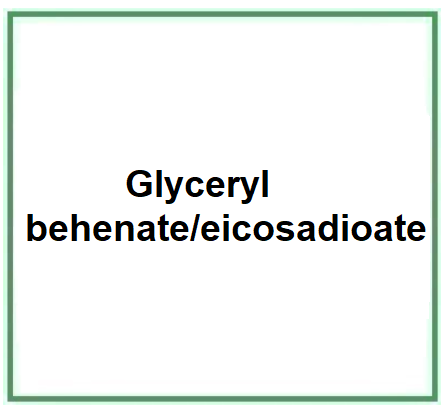Glyceryl Behenate/Eicosadioate is an ester of glycerin, 1,2,3-Propanetriol and behenic and eicosadienoic acids.
Raw Materials Used in Production.
Glyceryl behenate/eicosadioate is an ester of behenic acid and eicosadienoic acid with glycerol. The raw materials include glycerol, behenic acid, and eicosadienoic acid, which are often derived from vegetable sources.
Step-by-step Summary of Industrial Chemical Synthesis Process.
- Preparation of Fatty Acids. The needed fatty acids, like behenic acid and eicosadienoic acid, are prepared or isolated from natural sources.
- Esterification. The fatty acids and glycerol undergo an esterification process, thus forming glyceryl behenate/eicosadioate.
- Purification. The product is purified to remove any impurities or byproducts.
- Modifications (if needed). Possible modifications of the product to tailor it to specific applications.
Form and Color.
It generally appears as a solid wax, and the color can range from white to pale yellow, depending on the purity level and raw materials used.
Cosmetics
In cosmetic product formulation, it is used as a skin and hair conditioning agent, and it may also function as an emulsifier, helping to keep aqueous and oily phases together in a formula. Glycerin esters are generally known for their emollient properties and the ability to provide a smooth, soft feel to the skin.
- Skin conditioning agent - Emollient. Emollients have the characteristic of enhancing the skin barrier through a source of exogenous lipids that adhere to the skin, improving barrier properties by filling gaps in intercorneocyte clusters to improve hydration while protecting against inflammation. In practice, they have the ability to create a barrier that prevents transepidermal water loss. Emollients are described as degreasing or refreshing additives that improve the lipid content of the upper layers of the skin by preventing degreasing and drying of the skin. The problem with emollients is that many have a strong lipophilic character and are identified as occlusive ingredients; they are oily and fatty materials that remain on the skin surface and reduce transepidermal water loss. In cosmetics, emollients and moisturisers are often considered synonymous with humectants and occlusives.
- Surfactant - Emulsifying agent. Emulsions are thermodynamically unstable and are used to soothe or soften the skin and emulsify, so they need a specific, stabilising ingredient. This ingredient forms a film, lowers the surface tension and makes two immiscible liquids miscible. A very important factor affecting the stability of the emulsion is the amount of the emulsifying agent. Emulsifiers have the property of reducing the oil/water or water/oil interfacial tension, improving the stability of the emulsion and also directly influencing the stability, sensory properties and surface tension of sunscreens by modulating the filmometric performance.
Commercial Applications.
Glyceryl behenate/eicosadioate is widely used in the cosmetic and pharmaceutical industry as a stabilizer, emulsifier, and skin-conditioning agent. It may also be used in formulations of skin and hair care products.
Makeup. Used in products like lipsticks and foundations, providing a smooth appearance and enhancing pigment dispersion.
Pharmaceutical Industry. Can be used as an excipient in pharmaceutical formulations to improve drug stability and bioavailability.
![]() Glyceryl behenate/eicosadioate
Glyceryl behenate/eicosadioate 

